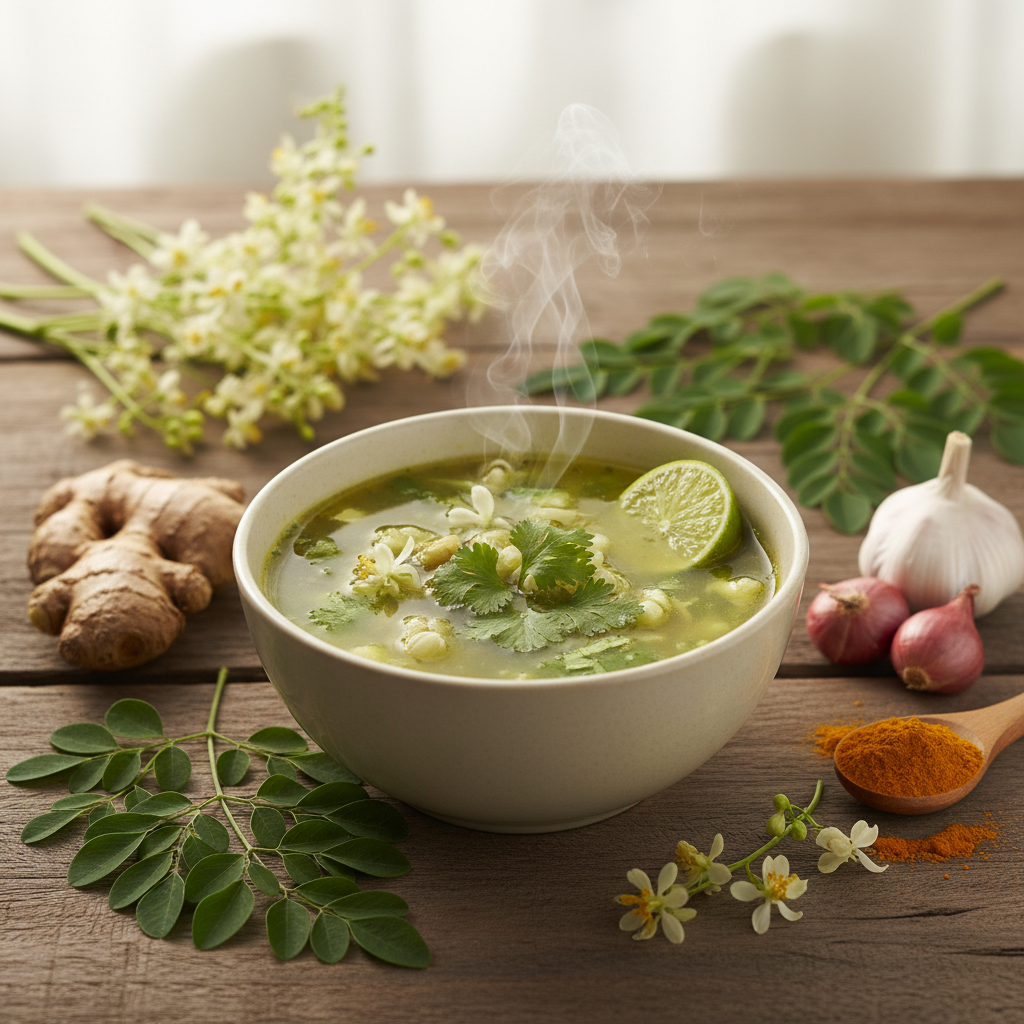Hey there, fellow food explorers and wellness enthusiasts! Let me tell you about a little secret I’ve been holding onto, a recipe that has truly become a staple in my kitchen, especially when I feel like my body needs a gentle hug and a powerful boost. We all know about moringa leaves, right? The “miracle tree” that’s packed with nutrients. But have you ever ventured into the delicate world of moringa flowers? Trust me, you’re in for a treat.
For a long time, my experience with moringa was limited to the powdered leaves in smoothies or the occasional leaf soup. Delicious, yes, but a bit too earthy for everyday craving. Then, a few years ago, while visiting a local farmer’s market, I stumbled upon a vendor selling fresh moringa flowers. They were tiny, cream-colored, and looked so unassuming. The vendor, an elderly woman with the kindest smile, urged me to try them. “They make the most wonderful, light soup,” she said, “good for the body, especially when you feel a bit tired.” Intrigued, I bought a small bag, mostly out of curiosity.
That evening, with no specific recipe in mind, I decided to improvise. I wanted something simple, something that would let the delicate flavor of the flowers shine. What emerged from my kitchen that day was a revelation: a light, herbal, and incredibly soothing moringa flower soup. It quickly became my go-to, not just for its subtle, unique taste, but for the noticeable warmth and wellness it brought to my system. It’s truly a hidden gem, and today, I’m thrilled to share my personal take on this wonderful, immune-boosting elixir with you.
My Journey with Moringa Flowers: From Curiosity to Cult Following
Honestly, when I first saw those little moringa flowers, I wasn’t entirely sure what to do with them. My initial thought was perhaps a stir-fry, but the vendor’s suggestion of soup stuck with me. I remembered my grandmother’s simple, clear broths that she’d make whenever anyone felt under the weather, focusing on fresh ingredients and gentle flavors. That’s the vibe I aimed for.
The first batch was a little experimental. I used basic aromatics – garlic, ginger, a hint of turmeric – and a good quality vegetable broth. The flowers, when cooked, retained their tender texture and imparted a subtle, almost sweet, slightly herbaceous note to the soup. It wasn’t overpowering like some herbal concoctions can be; instead, it was refreshing and comforting. I felt an immediate sense of lightness and warmth after drinking it. It felt like my body was silently thanking me.
Over time, I refined the recipe, adding a few elements here and there, always keeping the core idea of “light and herbal” intact. This soup has been my companion through seasonal sniffles, stressful weeks, and just those days when I crave something wholesome and clean. It’s an act of self-care in a bowl, and I can honestly say I feel more resilient and energized when I regularly include it in my diet.
Why Moringa Flowers? Unpacking the Gentle Power
So, why all the fuss about these tiny flowers? While moringa leaves get most of the spotlight for their incredible nutritional profile (vitamins A, C, E, calcium, potassium, protein – you name it!), the flowers are no slouch. Traditional medicine systems have long recognized the health benefits of moringa in its entirety, and the flowers are particularly lauded for their:
- Immune-Boosting Properties: Like the leaves, moringa flowers are rich in antioxidants, which help fight off free radicals and support a robust immune system. I always feel a bit more fortified after a bowl, especially during flu season.
- Anti-inflammatory Benefits: They are believed to possess anti-inflammatory compounds, which can help soothe various bodily discomforts. For someone like me who occasionally deals with mild aches, this is a gentle relief.
- Digestive Aid: In traditional uses, moringa flowers are sometimes consumed to aid digestion. I’ve personally noticed a sense of lightness and improved gut comfort after enjoying this soup.
- Delicate Flavor: Unlike the leaves which can be quite pungent, the flowers have a milder, sweeter, almost mushroom-like undertone when cooked. This makes them incredibly versatile and pleasant to eat.
It’s not just folklore; modern research is increasingly supporting these traditional claims. But for me, the proof is in how I feel – and I feel genuinely good when this soup is part of my routine.
The Recipe: My Go-To Moringa Flower Soup
Alright, enough talk! Let’s get down to the magic. This recipe is simple, forgiving, and incredibly rewarding. Feel free to adjust the spices to your liking!
Ingredients:
- 2 cups fresh moringa flowers (gently packed)
- 1 tablespoon extra virgin olive oil or coconut oil
- 1 medium shallot, finely chopped (or ½ small onion)
- 2 cloves garlic, minced
- 1-inch piece of ginger, grated or finely minced
- ½ teaspoon ground turmeric
- ¼ teaspoon black pepper
- 4 cups vegetable broth (low sodium preferred)
- Salt to taste (start with ½ teaspoon)
- Juice of ½ a lime or lemon (optional, for brightness)
- Fresh cilantro or mint for garnish (optional)
- A pinch of red chili flakes (optional, for a little kick)
Instructions:
- Prepare the Moringa Flowers: Gently rinse the moringa flowers under cool water. Pat them dry with a clean kitchen towel. Remove any tiny stems or leaves that might be attached, though a few won’t hurt.
- Sauté Aromatics: In a medium pot or Dutch oven, heat the olive oil over medium heat. Add the chopped shallot and cook until softened and translucent, about 3-4 minutes.
- Add Garlic and Ginger: Stir in the minced garlic and grated ginger. Cook for another 1-2 minutes until fragrant, being careful not to burn the garlic.
- Introduce Spices: Add the ground turmeric and black pepper. Stir well and cook for about 30 seconds, allowing the spices to bloom. This deepens their flavor. If using chili flakes, add them now.
- Pour in Broth: Carefully pour in the vegetable broth. Bring the mixture to a gentle simmer.
- Add Moringa Flowers: Once simmering, add the prepared moringa flowers to the pot. Stir gently.
- Simmer and Season: Reduce the heat to low, cover the pot, and let the soup simmer for about 5-7 minutes. The flowers cook quite quickly and you want them tender, not mushy.
- Taste and Adjust: Remove from heat. Taste the soup and adjust salt as needed. This is also when I like to add a squeeze of fresh lime or lemon juice – it really brightens up the flavors and adds a lovely tang.
- Serve: Ladle the hot soup into bowls. Garnish with fresh cilantro or mint, if desired. Serve immediately and enjoy the warmth!
Tips for Success:
- Sourcing Flowers: Fresh moringa flowers can be found at Asian or international markets, health food stores, or directly from local farms. If fresh isn’t an option, some places sell dried moringa flowers, which can also be used (rehydrate them first).
- Broth Quality: A good quality vegetable broth makes a huge difference. I often make my own, but a good store-bought organic, low-sodium option works wonders.
- Don’t Overcook: Moringa flowers are delicate. Overcooking them can lead to a slightly bitter taste and a mushy texture. Stick to the 5-7 minute simmer.
- Make it Vegan: This recipe is naturally vegan! Just ensure your broth is plant-based.
Taste & Texture: What to Expect from Your Bowl of Goodness
When you take your first spoonful, don’t expect a heavy, rich soup. This is all about subtlety and clarity. The broth is light and aromatic, infused with the gentle warmth of ginger and turmeric. The moringa flowers themselves offer a delicate, slightly sweet, and earthy flavor, almost like a very mild, tender mushroom. They have a pleasant, slightly chewy texture that contrasts beautifully with the smooth broth.
The lime or lemon juice at the end is crucial for me; it adds a burst of freshness that elevates all the other flavors, preventing the soup from feeling too “flat” or one-note. It’s a comforting, clean taste that leaves you feeling nourished and refreshed, not heavy.
Beyond the Bowl: My Personal Wellness Experience
I’m not a doctor or a nutritionist, but I can tell you what I’ve personally experienced since making this soup a regular part of my diet. When I feel a cold creeping in, or just generally run down, a bowl of this soup feels like hitting a “reset” button. I often wake up the next day feeling less congested, more energetic, and just generally more vibrant.
There was one time last winter when everyone around me seemed to be battling nasty colds. I made this soup almost every other day, and while I did feel a slight tickle in my throat at one point, it never escalated into a full-blown illness. I genuinely believe the consistent intake of this nutrient-dense, immune-supportive soup played a significant role in helping my body fight it off. It’s not a miracle cure, but it’s certainly a powerful ally in my personal wellness arsenal.
Conclusion: Your New Favorite Herbal Elixir Awaits
So there you have it, my cherished recipe for a light, herbal, and immune-boosting moringa flower soup. It’s more than just a recipe; it’s a practice of nourishing your body with simple, wholesome ingredients and listening to what it needs. If you’ve never tried moringa flowers before, I truly hope this inspires you to seek them out. It’s an easy, delicious, and incredibly beneficial way to tap into the gentle power of nature.
Give it a try, experiment with your favorite aromatics, and let me know how it makes you feel. I have a strong feeling this delicate elixir will quickly become a beloved part of your culinary and wellness journey too. Happy cooking, and here’s to feeling wonderfully well!




